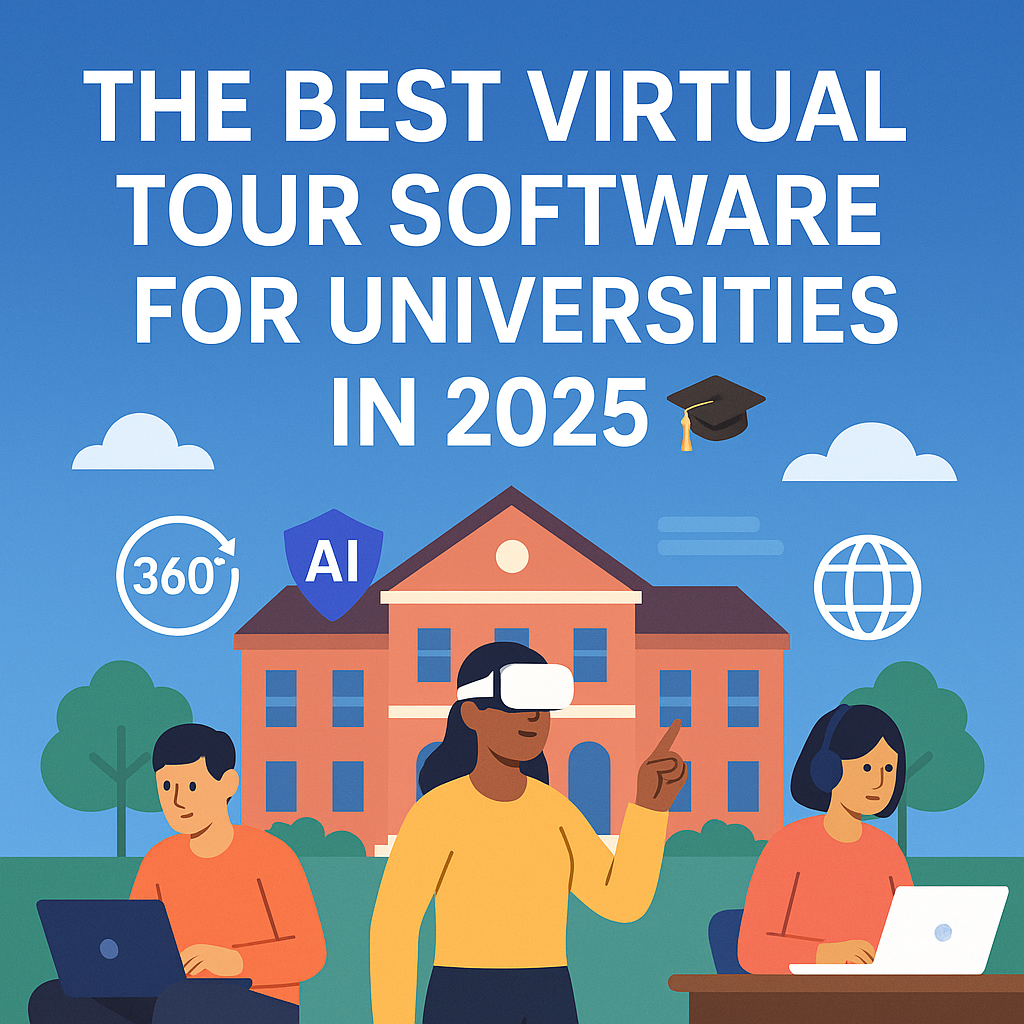🎓 The Best Virtual Tour Software for Universities in 2025 🌍
✨ Transforming How Universities Connect with Students
In 2025, students no longer choose universities based solely on glossy brochures or word of mouth. They expect interactive, immersive digital experiences that help them feel connected before they ever apply. 🌐
That’s where virtual tour software comes in. It’s not just a tech trend — it’s now a must-have marketing tool for universities looking to attract, engage, and convert students globally. Want to explore virtual campus tours? See what CloudPano offers universities here: CloudPano for Universities.
From 360° campus walkthroughs to AI-guided storytelling, the best virtual tour platforms in 2025 make every student feel like they’re already part of your campus family. 💫 A real estate video app makes it easy for agents to turn listing photos into high-quality videos that boost MLS visibility.
In this guide, we’ll explore what makes great virtual tour software, which platforms dominate the higher-education space this year, and how you can use them to boost enrollment, accessibility, and engagement. 🚀Discover how universities are boosting student enrollment with immersive virtual campus tours powered by CloudPano.
🧭 Why Virtual Tours Matter More Than Ever
The world of higher education is changing fast. Students from around the globe want access, transparency, and authentic experiences.
Here’s why virtual tours are essential for universities in 2025:
- 🌍 Global recruitment: Reach international students who can’t visit in person.
- ⏰ 24/7 access: Let prospects explore your campus anytime, anywhere.
- ♿ Accessibility: Offer equal opportunities to all students, regardless of physical limitations.
- 💬 Emotional connection: Let students feel what campus life is really like.
- 📈 Higher conversions: Virtual tours increase student inquiries and applications by up to 40%.
Whether your university is targeting domestic or international enrollment, a great virtual tour can turn interest into intent — and intent into applications. 🎯
Read: CloudPano for Universities: The Future of College Admissions Marketing
🏫 What to Look for in Virtual Tour Software
Not all platforms are created equal. When choosing the best virtual tour software for universities, focus on features that make your campus come alive.
Here’s what you should look for:
🌐 1. Interactive 360° Experiences
Your platform should allow smooth navigation through panoramic views of classrooms, dorms, athletic centers, and outdoor spaces.
Students should be able to move freely, zoom in, and explore hotspots that share text, images, and videos.
🎥 2. Video and Voice Integration
Add human warmth through narration, faculty interviews, or student testimonials. These features create emotional depth and authenticity.
🧠 3. AI or Live-Guided Tours
Some platforms (like CloudPano) let your admissions team host real-time guided tours where students can ask questions live. Others use AI to automatically guide visitors through the experience based on their interests.
📱 4. Mobile Optimization
Most students will view your tour on a phone. The best software loads quickly, supports touch gestures, and maintains full interactivity on any device.
🎨 5. Custom Branding
Universities need to look professional. Choose software that lets you add your logo, colors, and style, creating a cohesive brand experience.
💬 6. CRM & Lead Capture Integration
Your virtual tour should double as a lead-generation tool — capturing emails, interests, and engagement data to fuel your recruitment campaigns.
🧩 7. Analytics Dashboard
Track where visitors click, how long they explore, and which scenes they love most. These insights help refine your admissions strategy.
🌟 The Best Virtual Tour Software for Universities in 2025
After reviewing dozens of platforms, here are the top virtual tour tools leading higher education in 2025 — ranked for usability, innovation, and impact.
🏆 1. CloudPano – The All-in-One Virtual Tour Platform for Universities
CloudPano remains the top choice for universities worldwide in 2025. It’s known for its ease of use, flexibility, and powerful marketing features — perfect for both small colleges and global universities.
Why universities love it:
- 🧭 Easy drag-and-drop 360° tour builder
- 🎥 Add videos, audio narration, and info hotspots
- 🌍 Create VR-compatible experiences for headsets
- 🧑💻 Host live guided tours with admissions reps
- 🖥️ Embed on websites, landing pages, and emails
- 📊 Capture leads and analyze engagement data
CloudPano tours are mobile-friendly, multilingual, and customizable — helping institutions like Harvard Extension, the University of Houston, and countless others showcase their campuses with stunning clarity.
If you want an affordable, professional, and scalable option, CloudPano is the clear winner for 2025. 🥇
🎥 2. Matterport – High-End Immersive 3D Mapping
Matterport has long been synonymous with 3D modeling and real estate tours, but in recent years, universities have started using it for academic spaces, research labs, and museums.
Key strengths:
- 🏗️ Photorealistic 3D “digital twin” experiences
- 🧩 Integrates with VR and AR systems
- 📸 Professional-quality 360° captures
While it’s visually impressive, Matterport requires specialized equipment and higher costs — making it best for large universities or institutions with dedicated marketing budgets. 💼
🧑💻 3. Kuula – Simple, Affordable, and Customizable
Kuula is another popular tool among universities, known for its budget-friendly pricing and clean design.
Highlights:
- 📷 Upload and connect 360° images easily
- 💬 Add info cards, hotspots, and images
- 🌐 Share across social media or embed on sites
Kuula’s simplicity makes it great for smaller schools or departments looking for an entry-level tour solution.
🌎 4. Pictastic.ai – The AI-Powered Staging and Visualization Tool
While originally built for real estate and architecture, Pictastic.ai has quickly become a game-changer for universities that want to show off future projects or renovations.
Features that stand out:
- 🤖 AI-generated staging of empty rooms and halls
- 🎓 Perfect for showing future dorms, libraries, or campuses under construction
- 📸 Integrates easily with 360° photo environments
For institutions expanding or remodeling, Pictastic.ai helps visualize what’s next — attracting donors, students, and partners. 🏗️
🏫 5. YouVisit (EAB) – The University-Specific Platform
YouVisit focuses exclusively on higher education. Their tours combine beautiful visuals with strategic storytelling for recruitment purposes.
Why universities use it:
- 🧭 Focused on prospective student engagement
- 🎓 Built-in analytics and lead capture
- 🗣️ Personalized content and student ambassador videos
While YouVisit tours are polished, the platform often requires enterprise-level contracts — so it’s best suited for larger universities with marketing teams.
🎓 6. Concept3D – Accessibility Meets Engagement
Concept3D has carved out a niche for universities that value inclusion and navigation tools.
Top features:
- ♿ ADA-compliant mapping tools
- 📍 Integrated campus maps with virtual tours
- 📊 Real-time analytics for engagement tracking
It’s great for helping online visitors transition into real-world navigation once they’re admitted — bridging digital and on-campus experiences seamlessly.
💡 How Universities Are Using Virtual Tours in 2025
Let’s take a look at how innovative universities are leveraging this technology beyond traditional campus walkthroughs. 👇
🧭 1. Global Student Recruitment
Virtual tours serve as digital ambassadors, giving international students 24/7 access to campus life. Schools like the University of Toronto and NYU Abu Dhabi use 360° experiences to attract global applicants.
🧑💻 2. Online Program Showcases
Universities with remote learning options are building “virtual campuses” — allowing online students to experience the same sense of belonging as on-campus peers.
🎓 3. Event Marketing & Orientation
Virtual tours are now used for open houses, graduation events, and even alumni fundraising campaigns. They create emotional engagement and convenience at the same time.
🧩 4. Accessibility & Inclusion
Universities like Stanford and MIT are integrating voiceover tours and multi-language options to ensure students of all backgrounds can explore easily.
🏗️ 5. Future Campus Planning
Some institutions are using virtual tours to showcase upcoming expansions or architectural concepts — combining AI visualization with immersive walkthroughs.
📈 The Measurable Benefits of Virtual Tours
Universities that invest in interactive 360° experiences are seeing real ROI:
- 📈 35–50% increase in website engagement time
- 💌 20% more inquiries from virtual tour visitors
- 💬 Improved student satisfaction during the application process
- 🧭 Higher event attendance for virtual open houses
When done right, a virtual tour becomes a powerful storytelling asset — not just for marketing, but for every department, from admissions to alumni relations.
🌱 Sustainability and Cost Efficiency
Virtual tours aren’t just innovative — they’re sustainable. 🌿
By replacing traditional in-person tours and printed materials, universities can reduce:
- ✈️ Travel-related emissions
- 🧾 Printing costs
- 🏛️ On-campus logistics expenses
This eco-friendly approach resonates deeply with Gen Z and Gen Alpha students who prioritize environmental responsibility. 🌎♻️
🔮 The Future of Virtual Tours: AI, VR, and Beyond
Looking ahead, the next wave of virtual tour technology will be even more personalized and interactive.
Expect to see:
- 🤖 AI guides that adapt the tour based on a student’s interests (e.g., “Show me dorms and student life.”)
- 🥽 VR headsets offering fully immersive campus visits
- 🧠 Predictive analytics helping admissions teams identify high-intent prospects
- 🎤 Voice-activated navigation for accessibility
In other words, universities won’t just show their campus — they’ll make students feel like they’re already there. 💙
Read: Virtual Tours for Universities: Highlighting Athletics and Student Life
❤️ Final Thoughts: Choose Experience Over Technology
The best virtual tour software for universities in 2025 isn’t necessarily the one with the most features — it’s the one that helps you tell your story authentically.
Whether you choose CloudPano for its marketing power, Matterport for its realism, or YouVisit for its enterprise-level features, the goal remains the same:
👉 Make every prospective student feel at home before they even arrive.
In the digital age of education, that’s not just marketing — that’s connection. 🌟
Your all-in-one virtual experience solution starts here.














.png)



.png)





.png)

.png)





